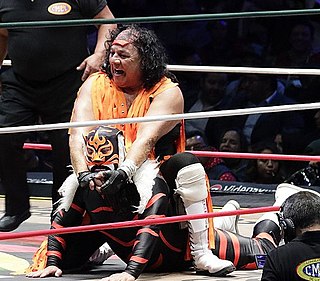
Jerry Estrada is a semi-retired Mexican luchador. For most of his career, he has portrayed a rudo character, nicknamed "El Puma". His rudo persona was pattered on various Glam Rock bands, complete with colorful spandex and what was described as a "rock and roll" attitude in the ring. He was originally active from 1978 until 2003 when he was forced to retire due to chronic injures caused by his signature bumps outside the ring. Estrada began working select matches again in 2018.
Triplemanía is the biggest annual professional wrestling event promoted by the Lucha Libre AAA Worldwide (AAA) promotion and is traditionally held in August each year. A majority of the shows have been presented as pay-per-view events, with some being shown as television specials on the Televisa channel or as streaming events on Twitch. The Triplemanía show features culminations of AAA's long building storylines. During the early years of Triplemanía, the event was not a presented as a single show, but a series of shows - either two or three per year. The show has been promoted for 29 years, with 36 shows in total promoted under the Triplemanía banner. The name is a combination of how "AAA" is pronounced in Spanish, "Triple A", and WrestleMania, WWE's biggest annual show. The latest event, Triplemanía Regia II, took place on December 4, 2021 at Estadio de Béisbol Monterrey in Monterrey, Mexico.

Triplemanía I was the first ever Triplemanía lucha libre, or professional wrestling show promoted by Asistencia Asesoría y Administración (AAA). The show took place on April 30, 1993 in Mexico City, Mexico's Plaza de Toros bullfighting arena. The Main event featured a "Retirement" match between Konnan and Cien Caras, where the storyline was that the person that lost would have to retire from professional wrestling. The match was billed as the first time such a stipulation had ever been used in Lucha Libre, while it was rare, retirement matches had happened in Mexico before that time. The semi-main event featured the zenith of the storyline feud between Perro Aguayo and Máscara Año 2000 as the two fought in a Lucha de Apuestas, or bet match, where Aguayo put his hair on the line and Máscara Año 2000 bet his wrestling mask on the outcome of the match.

Triplemanía II-A was a major lucha libre, or professional wrestling event Asistencia Asesoría y Administración (AAA) that took place at the Aguascalientes baseball stadium on April 26, 1994. The show was the first of three Triplemanía II shows held in 1994 with two subsequent shows held in May. 1994 was the first year AAA held multiple Triplemanía shows in a year, a tradition they would continue through 1997, after which Triplemanía became a single annual event. The annual Triplemanía show(s) are AAA's biggest show of the year, serving as the culmination of major storylines and feature wrestlers from all over the world competing in what has been described as AAA's version of WrestleMania or their Super Bowl event.

Triplemanía II-B was a major lucha libre, or professional wrestling event Asistencia Asesoría y Administración (AAA) that took place at Auditorio Benito Juárez in Zapopan, Jalisco on May 15, 1994. The show was the second of three Triplemanía II shows held in 1994, preceded by Triplemanía II-A, with a subsequent show held in 12 days later. 1994 was the first year AAA held multiple Triplemanía shows in a year, a tradition they would continue through 1997, after which Triplemanía became a single annual event. The annual Triplemanía show(s) are AAA's biggest show of the year, serving as the culmination of major storylines and feature wrestlers from all over the world competing in what has been described as AAA's version of WrestleMania or their Super Bowl event.

Triplemanía II-C was a major lucha libre, or professional wrestling event Asistencia Asesoría y Administración (AAA) that took place at the El Toreo bullfighting arena in Tijuana, Baja California, Mexico on May 27, 1994. The show was the final of three Triplemanía II shows held in 1994, preceded by Triplemanía II-A in April and Triplemanía II-B held 12 days prior. 1994 was the first year AAA held multiple Triplemanía shows in a year, a tradition they would continue through 1997, after which Triplemanía became a single annual event. The annual Triplemanía show(s) are AAA's biggest show of the year, serving as the culmination of major storylines and feature wrestlers from all over the world competing in what has been described as AAA's version of WrestleMania or their Super Bowl event. The May 27th show was the fourth overall show produced under the Triplemanía banner.
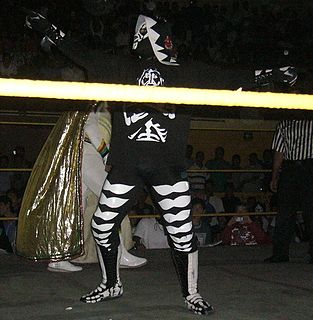
Triplemanía III-A was the first of three parts of the third Triplemanía professional wrestling show series promoted by Asistencia Asesoría y Administración (AAA). 1995 was second year to feature the "Triplemanía Series" of shows with 3, referred to as III-A, III-B and III-C. The show took place on June 10, 1995 in Tijuana, Baja California, Mexico. The Main event featured a 13-wrestler Steel Cage Elimination match, Lucha de Apuestas "Mask vs. Mask" match featuring the "Mini-Estrellas" division. The participants included Ninjita, Espectrito I, Espectrito II, Jerrito Estrada, Fuercita Guerrera, Mascarita Sagrada, Mini Calo, Octagoncito, La Parkita, Payasito Rojo, Payasito Azul, Super Muñequito, and Torerito. This marked the first and so far only time that the "Minis division" was featured in the main event of a Triplemanía. The show also featured the first of three Lucha de Apuestas, mask vs. mask match series for the Triplemanía III shows as the culmination of a storyline feud between the tecnico team of Super Caló and Winners against the Rudo team known as Los Diabolicos. Six of the eight matches were later shown on AAA's weekly Televisa show.
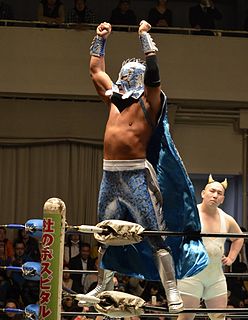
Triplemanía IV-A was a major lucha libre, or professional wrestling, show promoted by the Mexican-based AAA and was the first of three Triplemanía IV shows held in 1996. The event took place on May 11, 1996 at the International Amphitheatre in Chicago, Illinois, United States and marked the first time AAA held a Triplemanía outside of Mexico and one of the few times Triplemanía was an international event. The annual Triplemanía show(s) are AAA's biggest show of the year, serving as the culmination of major storylines and feature wrestlers from all over the world competing in what has been described as AAA's version of WrestleMania or their Super Bowl event.

Triplemanía III-B was the second part of the third Triplemanía professional wrestling show promoted by Asistencia Asesoría y Administración (AAA). 1995 was second year to feature the "Triplemanía Series" of shows with 3, referred to as III-A, III-B and III-C, where this was the second of the series. The show took place on June 18, 1995 in Tonala, Mexico. The Main event featured a Best two out of three falls Lucha de Apuestas "Mask vs. Mask" match where both Winners and Marabunta put their mask on the line.
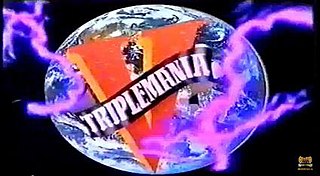
Triplemanía V-A was the first part of the fifth Triplemanía professional wrestling show promoted by AAA. 1997 was fourth year to feature the "Triplemanía Series" of shows with two, referred to as V-A and V-B, where this was the first of the series. The show took place on June 13, 1997 in Tijuana, Mexico. The Main event featured a Six-man "Lucha Libre rules" tag team match between the teams of Perro Aguayo, Tinieblas Jr. and Canek and Jake Roberts, Killer, and Gorgeous George III.

Triplemanía V-B was the second part of the fifth Triplemanía professional wrestling show promoted by AAA. 1997 was fourth year to feature the "Triplemanía Series" of shows with two, referred to as V-A and V-B, where this was the second and final of the series. The show took place on June 15, 1997 in Naulcalpan, Mexico. The main event featured an eight-man "Atómicos" tag-team match between the teams of Perro Aguayo, Octagón, Cibernético and El Canek and Jake Roberts, Gorgeous George III, El Cobarde Jr. and Fuerza Guerrera.

Triplemanía VII was the seventh Triplemanía professional wrestling show promoted by AAA. The show took place on June 11, 1999, in Madero, Mexico. The Main event featured a Six-man "Lucha Libre rules" tag team match between the teams of Perro Aguayo, Octagón and El Cobarde II and El Texano, Perro Aguayo Jr. and Sangre Chicana. In the semi-main event Heavy Metal and El Felino defended the hair of their father, referee Pepe "Tropi" Casas while Kick Boxer and Thai Boxer defended the hair of referee El Tirantes. As a result, El Tirantes had his hair shaved off after the match.
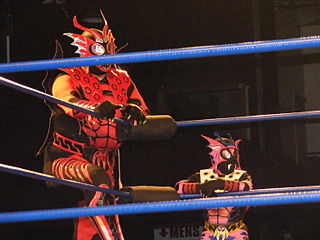
Triplemanía IX was the ninth Triplemanía professional wrestling show promoted by AAA. The show took place on May 26, 2001 in Mexico City, Mexico. The Main event featured a Dog collar match Lucha de Apuestas match where the last man remaining in the match would have his hair shaved off. The participants were Pirata Morgan, El Cobarde and Sangre Chicana.

Triplemanía XI was the eleventh Triplemanía professional wrestling show promoted by AAA. The show took place on June 15, 2003 in Naucalpan, Mexico. The Main event featured an Eight-man "Atómicos" tag team match where the team of Lizmark, La Parka, Octagón and Super Caló faced the team of Abismo Negro, Cibernético and The Headhunters.

Triplemanía XII was the twelfth Triplemanía professional wrestling show promoted by AAA. The show took place on June 20, 2004 in Naucalpan, Mexico like the previous year’s event. The Main event featured a Lucha de Apuestas "Mask vs. mask" match between La Parka and Cibernético.

Triplemanía XIV was the fourteenth Triplemanía professional wrestling show promoted by AAA. The show took place on June 18, 2006 in Naucalpan, Mexico. The Main event featured a Lucha de Apuestas "Mask vs. Mask" match. The two men that put their masks on the line were La Parka and Muerta Cibernética.

Triplemanía XV was the fifteenth Triplemanía professional wrestling show promoted by AAA. The show took place on July 15, 2007 in Naucalpan, Mexico like the previous year’s event. The Main event featured a Domo De La Muerte cage match where the last person in the cage would have his hair shaved off. The match featured the teams of Los Hell Brothers and La Legión Extranjera.

Jesús Reyes González is a Mexican Luchador, or professional wrestler, best known under the ring name Máscara Año 2000 or Máscara Año Dos Mil. His ring name is Spanish for "Mask of the year 2000", originally referring to the mask Reyes wore while wrestling. Reyes was forced to unmask when he lost a Lucha de Apuesta to Perro Aguayo in 1993. Throughout his career Reyes has often teamed with his two brothers Carmelo, who wrestles as Cien Caras and the late Andrés, who wrestled as Universo 2000, the three were collectively known as Los Hermanos Dinamita or Los Capos when they teamed with Apolo Dantés. Reyes has earned the nickname "El Padre de más de 20" by wrestling commentators even though he does not quite have 20 children.

Perros del Mal Producciones, often referred to as just 'Perros del Mal', was a Mexican professional wrestling promotion founded in October 2007 by Perro Aguayo, Jr. when he left Consejo Mundial de Lucha Libre and became inactive around 2015. The promotion shared a name with Aguayo, Jr.'s wrestling stable (group) Los Perros del Mal and the stable is the main Rudo (villain) group in the promotion. The promotion had an "open door policy" which meant they did not generally have wrestlers under contract but hired them on a per appearance basis. Perros del Mal was also a booking agency, responsible for hiring the core Perros del Mal group and others to various independent promotions all over Mexico.
Maniaco is a Mexican Luchador, or professional wrestler best known for being a part of the Asistencia Asesoría y Administración (AAA) group Los Vipers. He currently works for Consejo Mundial de Lucha Libre (CMLL), although the storyline portrays him as an outsider, part of Los Independientes. Maniaco is a former four time holder of the Mexican National Atómicos Championship along with Histeria, Mosco de la Merced II and Psicosis II.















